#herbig-haro
Photo

HH 24: Star-birth Fireworks © Gemini Observatory
#space#herbig-haro#astrophotography#universe#stars#night sky#planet#galaxy#planets#astronomy#solar system#cosmos#nebula
775 notes
·
View notes
Photo

‘TRUST THE MAGIC OF BEGINNINGS’
NASA posted a photo on Tuesday of cosmic clouds called “Herbig-Haro objects,” which is an indication of a newly-formed star.
In an Instagram post, the space agency explained that it is formed when young stars discharge superheated jets of gas into space and collide with colder surrounding materials.
“With Herbig-Haro objects, there is more than meets the eye. These cosmic objects help astronomers understand the turbulent interactions within stellar nurseries—and can help us pinpoint the location of stars invisible to the human eye,” NASA wrote.
Instagram/NASA
#art#photography#nasa#cosmos#cosmic#universe#star#herbig-haro#stellar#instagram#stars#cosmos wallpaper
3 notes
·
View notes
Text
Getti, da una stella in formazione
Dalla ricerca (immaginata) in autobus, ad uno degli interrogativi importanti dello studio delle stelle in formazione. Con una immagine fantastica (letteralmente) e una reale ed ancora più bella!
Vado subito al dunque: quando una stella si forma, origina sempre dei getti di materia? Tutti ce lo siamo chiesti molto spesso, a volte con un’ansia di trovare la risposta, che non ci permette alcuna tregua. Lo so, sono domande che indubbiamente ci assillano: vedo in metropolitana, sul tram, tutte queste persone impegnate a fare calcoli, discutere teorie, immaginare scenari, litigare sulle…

View On WordPress
0 notes
Text

A pair of actively forming stars: HH 46/47 l Webb
#webb#nasa#space#james webb telescope#herbig haro#astrophotography#astronomy#galaxy#stars#night#solar system#universe#planets#sky
1K notes
·
View notes
Text
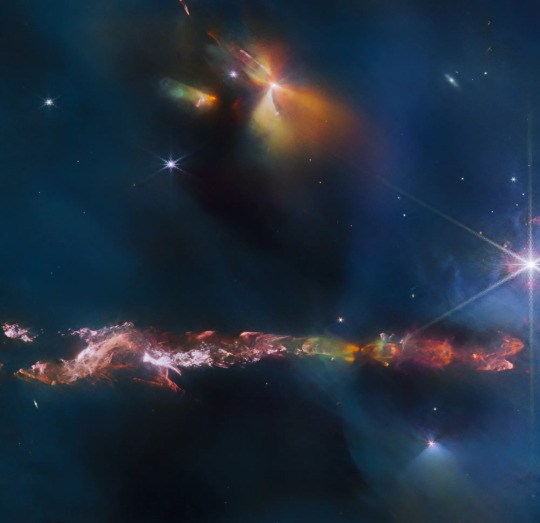
James Webb Space Telescope reveals intricate details of the Herbig Haro object 797 (November 28, 2023)
#jwst#jwst images#james webb images#james webb space telescope#astronomy#astrophotography#krakenmare#outer space#space#thank you nasa#nasa#herbig haro#hh797
684 notes
·
View notes
Text

Forming Stellar Duo
280 notes
·
View notes
Text

Herbig–Haro object - Skylar over at instagram - described it at the link below.
instagram
7 notes
·
View notes
Text
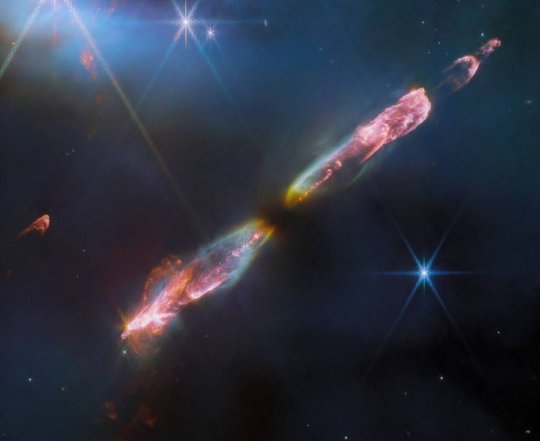
NASA’s Webb Snaps Supersonic Outflow of Young Star
NASA’s James Webb Space Telescope’s high resolution, near-infrared look at Herbig-Haro 211 reveals exquisite detail of the outflow of a young star, an infantile analogue of our Sun. Herbig-Haro objects are formed when stellar winds or jets of gas spewing from newborn stars form shock waves colliding with nearby gas and dust at high speeds. The image showcases a series of bow shocks to the southeast (lower-left) and northwest (upper-right) as well as the narrow bipolar jet that powers them in unprecedented detail. Molecules excited by the turbulent conditions, including molecular hydrogen, carbon monoxide and silicon monoxide, emit infrared light, collected by Webb, that map out the structure of the outflows.
Credits: ESA/Webb, NASA, CSA, T. Ray (Dublin Institute for Advanced Studies).
#james webb telescope#james webb space telescope#james webb photos#james webb images#NASA’s Webb Snaps Supersonic Outflow of Young Star#Herbig-Haro 211#space#nasa#nasa photos#nasa picture of the day#pretty#beauty#beautiful
25 notes
·
View notes
Text

"Webb peeks into Perseus" and the reflection nebula NGC 1333 embedded there, and sees 'baby star jets', aka Herbig-Haro objects.
NGC 1333 "is in the Perseus molecular cloud, and located approximately 960 light-years away."

Map of the Perseus molecular cloud - Wikipedia.
3 notes
·
View notes
Text




?
#jwst#james webb space telescope#herbig-haro 46/47#?#bok globule#gum nebula#vela and puppis constellations
26 notes
·
View notes
Text

Herbig-Haro Jet HH 24 Constellation Of Orion.
75 notes
·
View notes
Photo

Young stars in Orion Nebula © Hubble
#space#nasa#hubble telescope#astrophotography#astronomy#herbig-haro#HH1#HH2#Orion Nebula#stars#night sky#galaxy#universe#planet#cosmos#planets#solar system
2K notes
·
View notes
Text
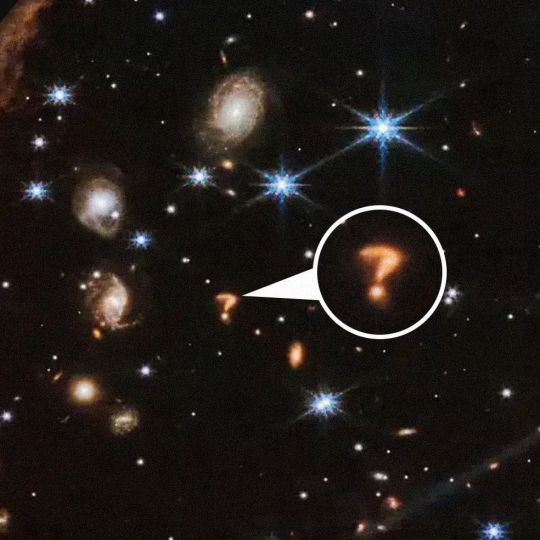

Cosmic Question Mark !
In a discovery that seems almost too perfect to be true, NASA’s James Webb Space Telescope has captured an image of a cosmic question mark. The strange phenomenon is, according to scientists, the result of the interaction of two galaxies.
The cosmic question mark is actually a part of a larger image. Webb recently captured the intricate dance of a pair of young stars, known as Herbig-Haro 46/47, through advanced near-infrared imaging.
The curious nickname of the image comes from the unusual shape of the galaxies, which seems to take the form of a question mark in our visual perception. They are actually two separate galaxies, engaged in a gravitational interaction that distorts their shape and modifies their trajectory.
Courtesy: Nasa
#art#cosmos#cosmic#universe#blast#photography#stars#question mark#surreal#nasa#james webb space telescope#galaxies#herbig-haro 46/47#infrated#gravity
253 notes
·
View notes
Text
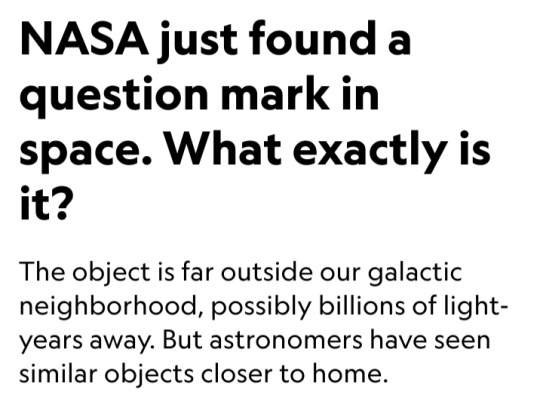
By Allie Yang
10 August 2023

Two of our galaxy’s most famous stars were recently photobombed by what appears to be a celestial question mark.
The symbol was spotted in a new image from the James Webb Space Telescope (JWST) of the forming stars Herbig-Haro 46/47, which are well-known and have been frequently observed by astronomers.
These two stars can provide clues about how our own sun may have formed.
They’re relatively close to Earth, about 1,400 light-years, and relatively young, only a few thousand years old.
In fact, they’re still in gestation and have not technically been “born” yet, which is marked when the stars start shining from their own nuclear fusion.
The image is the first of the twin protostars from the NIRCam instrument on JWST.
It was captured using infrared light, which penetrates space dust more easily than visual light, and it is the highest resolution image of the objects ever seen at these wavelengths.
The telescope’s astonishing sensitivity allowed the glowing red question mark to be captured in the lower center of the image.
The object is far outside our galactic neighborhood, possibly billions of light-years away, says Christopher Britt, an education and outreach scientist at the Space Telescope Science Institute who helped plan these observations.
His best guess is that the question mark is actually two galaxies merging.
“That's something that's seen fairly frequently, and it happens to galaxies many times over the course of their lives,” he says.
“That includes our own galaxy, the Milky Way … [it] will merge with Andromeda in about four billion years or so.”
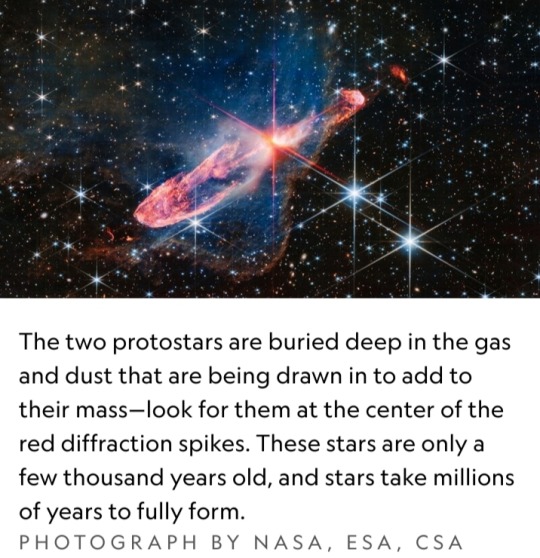
The hints pointing to two galaxies are found in the question mark’s strange shape.
There are two brighter spots, one in the curve and the other in the dot, which could be the galactic nuclei, or the centers of the galaxies, Britt says.
The curve of the question mark might be the “tails” being stripped off as the two galaxies spiral toward each other.
“It's very cute. It's a question mark … But you can find the colons and semicolons, and any other punctuation mark, because you have 10,000 little smudges of light in each image taken every half hour,” says David Helfand, an astronomer at Columbia University.
The sheer number of shining objects we find are bound to create some serendipitous images, and our brains have evolved to find those patterns, he says.
Astronomers have seen similar objects closer to home.
Two merging galaxies captured by the Hubble Space Telescope in 2008 also look like a question mark, just turned 90 degrees.
Helfand says the question mark seems to be two objects, the curve and the dot, but could be more that just happened to line up.
They could also be completely unrelated objects, he says, if one is much closer to Earth than the other.
Britt warns that estimating distance based only on colors in the image can be tricky.
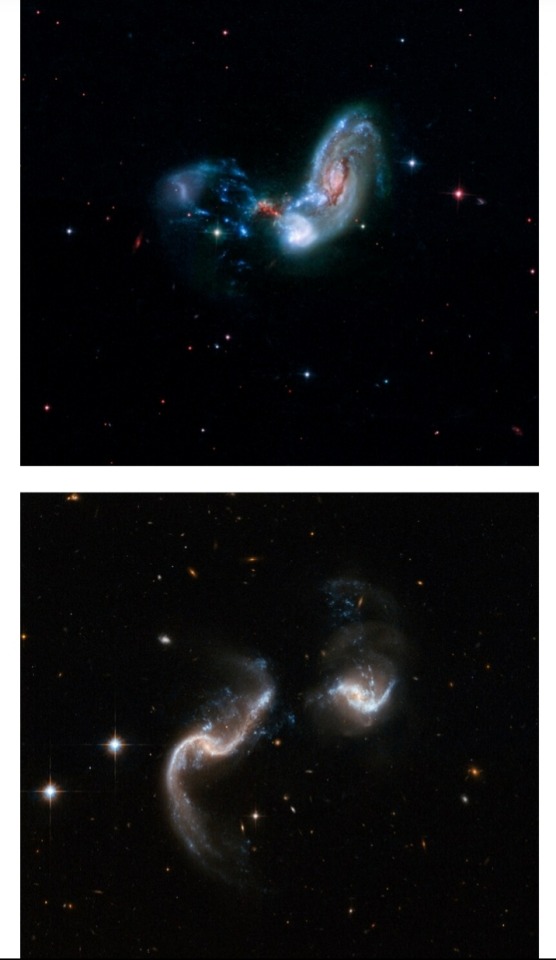
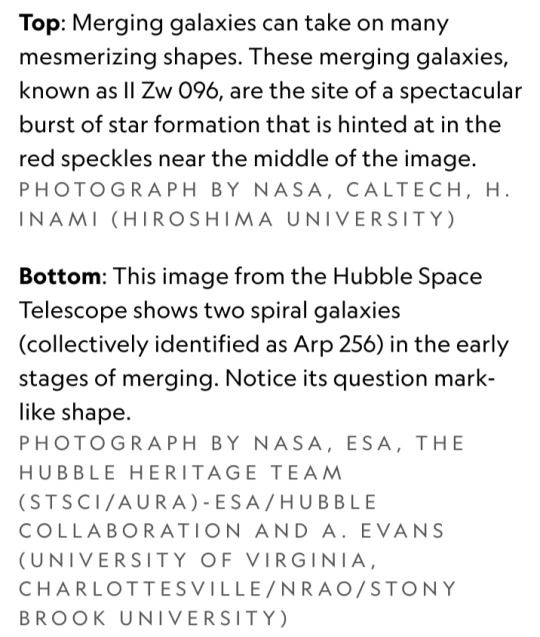
The red of the question mark could mean it’s very far away (light waves stretch as they travel through the expanding universe, shifting to redder wavelengths) or that it’s closer and obscured by dust near the object.
It would take more investigation to identify exactly how far away the question mark is.
This could be done by measuring photometric redshifts, determined by the brightness observed through different filters, but this would only provide an estimate for the distance, Britt says.
Spectroscopy, which analyzes light from the source to determine its elemental makeup, could provide a more exact distance but requires a separate instrument to measure.
Given the number of intriguing targets spotted by JWST, the question mark may never receive this treatment.
For now, the source of this symbol in the sky remains a cosmic mystery.
#James Webb Space Telescope (JWST)#celestial question mark#stars#galaxy#space#astronomy#Herbig-Haro 46/47#NIRCam#infrared light#protostars#Christopher Britt#Space Telescope Science Institute#galactic nuclei#astronomers#Hubble Space Telescope#photometric redshifts#Spectroscopy#cosmic mystery#National Geographic#Nat Geo#NASA
9 notes
·
View notes
Text

An image captured by the James Webb Space Telescope portrays Herbig-Haro 46/47, or simply HH 46/47, a nebula of ionized gas that emits a faint light in which two lobes are very bright instead. The two numbers are due to the fact that there are two young stars still growing in the middle of a disk of gas and dust. Webb's NIRCam (Near-Infrared Camera) instrument captured details of that area never seen before. The nebula is invisible at optical frequencies and is blue at infrared. The most spectacular part is the one characteristic of the Herbig-Haro objects with the ionized stellar winds forming two lobes visible in the image in orange hues.
4 notes
·
View notes
Text

JWST: Near-infrared look at Herbig-Haro 211 reveals exquisite detail of the outflow of a young star, an infantile analogue of our Sun (August 28, 2022)
#jwst#james webb images#james webb space telescope#astronomy#astrophotography#outer space#krakenmare#space#nasa#thank you nasa#herbig haro#herbig haro 211#hh 211#2020s#2022#star#stars
65 notes
·
View notes